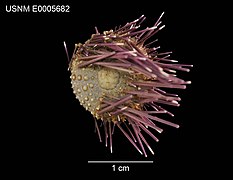You can help expand this article with text translated from the corresponding article in French. (February 2024) Click for important translation instructions.
|
| Echinostrephus aciculatus | |
|---|---|

| |
| Scientific classification | |
| Domain: | Eukaryota |
| Kingdom: | Animalia |
| Phylum: | Echinodermata |
| Class: | Echinoidea |
| Order: | Camarodonta |
| Family: | Echinometridae |
| Genus: | Echinostrephus |
| Species: | E. aciculatus |
| Binomial name | |
| Echinostrephus aciculatus A. Agassiz, 1863 | |
Echinostrephus aciculatus is a species of sea urchin belonging to the family Echinometridae first documented by Alexander Emmanuel Rodolphe Agassiz in 1863.
Description
These are regular urchins of canonical form, with the test mostly spherical, bearing a pentaradial symmetry from the mouth at the center of the oral face to the anus on the aboral face. Spines are thin, pointy and of average length.
The test measures from 2 to 4 centimetres (0.79 to 1.57 in) in diameter, and the color of the spines is very variable: they are often brown-purple, but can be shades of purple, brown, black, grey or off-white. Those on the oral face can also have a cream color with brown-purple rings, although they are rarely visible. The test ranges from black to light brown, with the bottom of the spines showing often highly contrasting rings. The apical disk is dark and lacking spines, forming a highly visible disk at the apex of the test.
-
 Oral view
Oral view
-
 Aboral view
Aboral view
-
 Spineless test
Spineless test
References
- "WoRMS - World Register of Marine Species - Echinostrephus aciculatus A. Agassiz, 1863". www.marinespecies.org. Retrieved 2024-02-05.
- Guille, Alain; Laboute, Pierre; Menou, Jean-Louis (1986). Guide des étoiles de mer, oursins et autres échinodermes du lagon de Nouvelle-Calédonie (in French). Paris: ORSTOM. ISBN 2-7099-0748-8.
| Taxon identifiers | |
|---|---|
| Echinostrephus aciculatus | |
 | This article about a sea urchin is a stub. You can help Misplaced Pages by expanding it. |